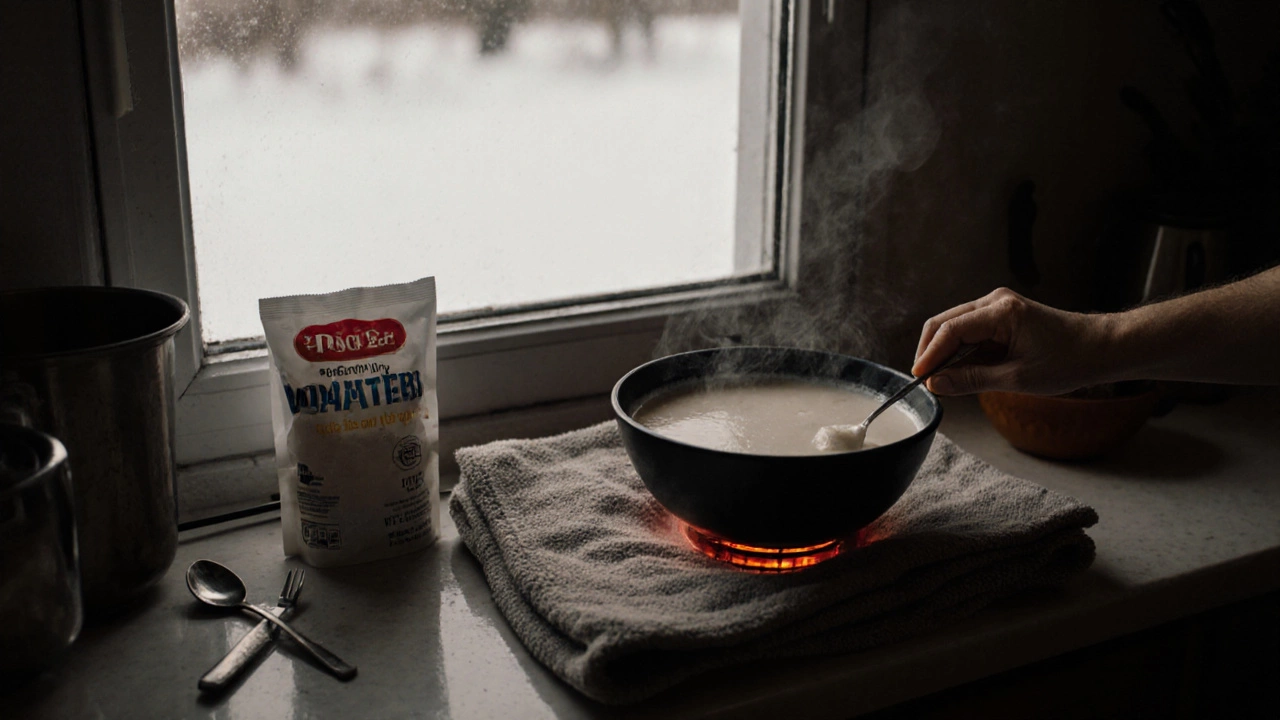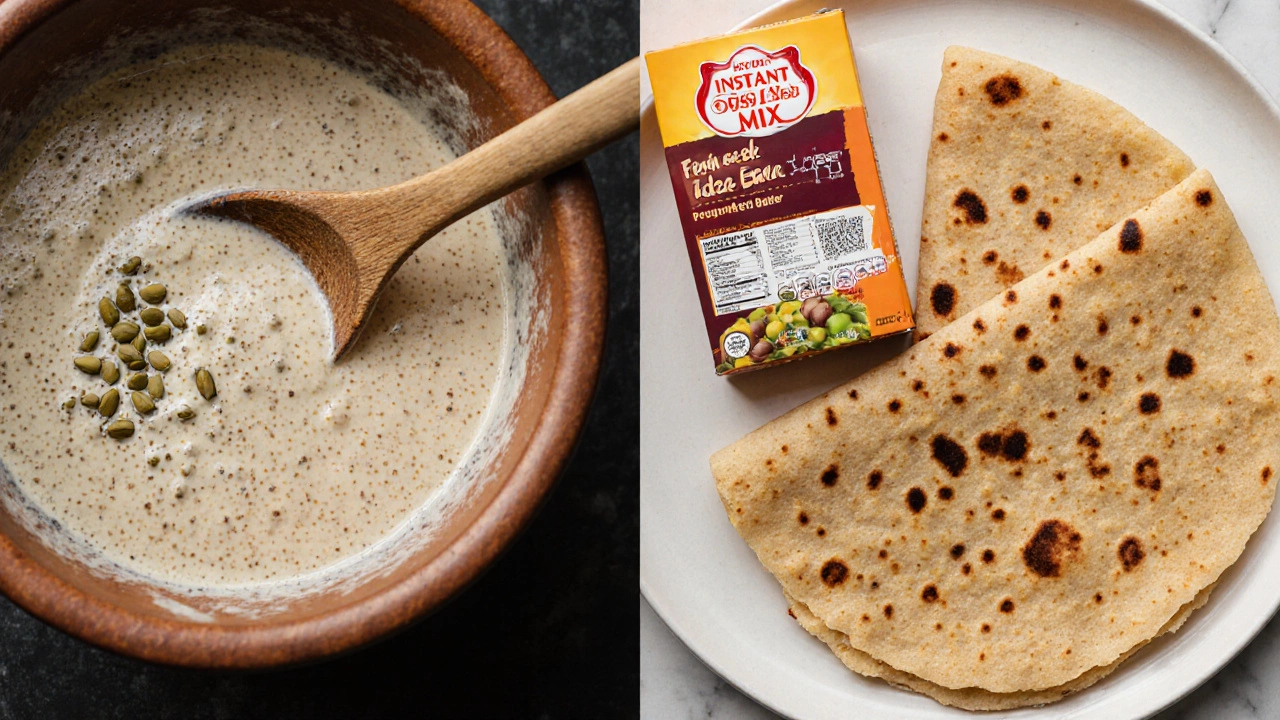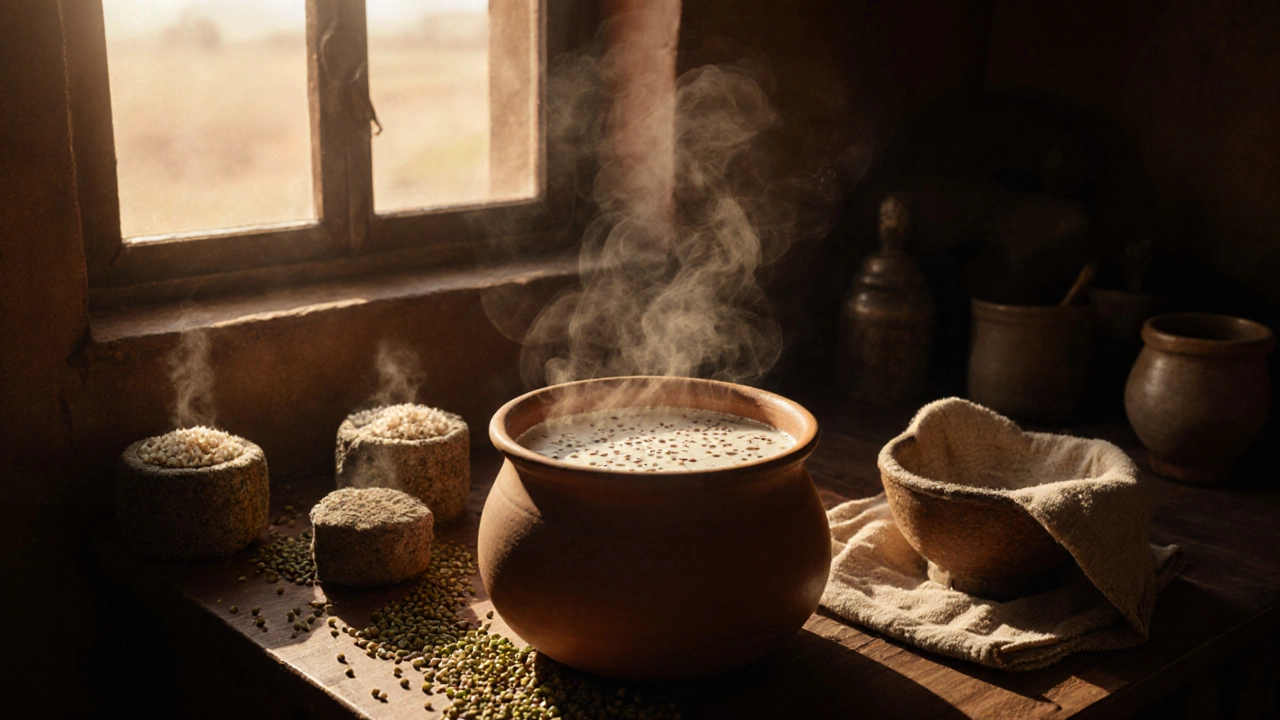Dosa Fermentation Time Calculator
How Long Will Your Batter Ferment?
Enter your kitchen temperature to get accurate fermentation time estimates. Based on traditional South Indian dosa preparation methods.
Enter your temperature and batter type to see fermentation estimates.
For decades, South Indian households have made dosa batter the old-fashioned way: soaking rice and urad dal overnight, grinding it coarse, and letting it ferment naturally for 8-12 hours. The result? Crispy, airy dosas with a subtle tang that no shortcut can truly replicate. But in today’s fast-paced kitchens, many wonder: Can you add yeast to dosa batter to speed things up? The short answer is yes-but it’s not always the best idea.
Why Traditional Fermentation Matters
Traditional dosa batter doesn’t just rely on time-it relies on biology. The mixture of rice and black gram (urad dal) contains natural wild yeasts and lactic acid bacteria already present in the environment, especially in warm, humid climates like Kerala or Tamil Nadu. These microbes feed on the starches and sugars in the batter, producing carbon dioxide bubbles that make the batter rise, and lactic acid that gives dosa its signature mild sourness.
This natural fermentation isn’t just about fluffiness. It also breaks down complex starches and phytic acid, making the batter easier to digest and more nutrient-dense. Studies show that fermented rice and legume batters have higher bioavailability of iron and B vitamins compared to unfermented ones. Skip fermentation, and you lose that hidden benefit.
What Happens When You Add Yeast
Commercial yeast-like the kind you buy in packets for bread-is a single strain of Saccharomyces cerevisiae. It’s engineered to ferment quickly and predictably. When you add a quarter teaspoon of active dry yeast to your dosa batter, it will indeed produce gas and make the batter rise faster-sometimes in as little as 3-4 hours, even in cooler kitchens.
But here’s the catch: yeast doesn’t produce lactic acid. That means your batter will puff up, but it won’t develop that familiar tang. The flavor ends up flat, almost bland. You might get a decently risen dosa, but it’ll taste more like a thin pancake than a true South Indian dosa.
Some home cooks try to fix this by adding a splash of lemon juice or yogurt to mimic sourness. But that’s a band-aid. Real fermentation isn’t just about acidity-it’s about a complex chain of microbial activity that yeast alone can’t replicate.

When Yeast Might Actually Help
There are situations where adding yeast makes sense:
- You live in a cold climate (like Bristol in winter) and your batter won’t ferment naturally even after 18 hours.
- You’re in a rush and need dosas for breakfast tomorrow, and you forgot to soak the grains the night before.
- You’re making dosa for a crowd and need consistent results without relying on unpredictable room temperature.
In these cases, yeast can be a practical tool. Use ¼ teaspoon of active dry yeast per cup of dry rice and urad dal combined. Mix it into the ground batter after grinding, then cover and let it sit in a warm spot (around 80-85°F) for 4 hours. Don’t overdo it-too much yeast can make the batter smell alcoholic or overly yeasty.
Better Alternatives to Yeast
If you want faster results without sacrificing flavor, try these proven tricks:
- Use warm water when grinding the batter. Water at 90-100°F helps activate natural microbes.
- Keep the batter near a heat source-like on top of a preheated oven or next to a radiator. In winter, some people place the batter bowl in a closed oven with the light on.
- Add a pinch of fenugreek seeds to the soaking grains. Fenugreek boosts fermentation by encouraging lactic acid bacteria growth. Just ½ teaspoon per cup of dal makes a noticeable difference.
- Use leftover fermented batter as a starter. Save 2 tablespoons of last week’s batter and mix it into your new batch. It’s like a sourdough starter for dosa.
These methods still rely on natural fermentation but make it faster and more reliable. No artificial additives needed.

What About Instant Dosa Mixes?
Many packaged dosa mixes claim to be “ready in 30 minutes.” They often contain baking powder, rice flour, and sometimes yeast or chemical leaveners. The result? A flat, rubbery dosa that lacks texture and depth. These mixes are convenient for occasional use, but they’re not real dosa. They’re more like savory crepes with a hint of rice flavor.
If you’re buying instant mix, check the ingredients. If you see “sodium bicarbonate,” “calcium carbonate,” or “yeast extract,” you’re getting a processed product. Stick to whole grains if you want the real thing.
The Verdict: Yeast Is a Compromise
Adding yeast to dosa batter won’t break your recipe-it’ll just change it. You’ll get a quicker rise, but you’ll lose the soul of the dish. The tang, the aroma, the digestibility-all come from the slow dance of wild microbes, not a packet from the supermarket.
Use yeast only when you have no other option. Otherwise, embrace the wait. Let your batter sit overnight. Feel the bubbles form. Smell the slight sourness. That’s not a delay-it’s part of the ritual.
Real dosa isn’t made in a hurry. It’s made with patience. And that patience? It shows in every bite.
Can I use baking powder instead of yeast in dosa batter?
Yes, you can use baking powder, but it won’t ferment the batter. Baking powder gives a quick lift through chemical reaction, not biological fermentation. The dosa will rise slightly but won’t develop tang or improve digestibility. It’s a last-resort option for when you’re out of time and yeast. Use ½ teaspoon per cup of batter, and mix it in right before cooking.
Why does my dosa batter not ferment in winter?
Cold temperatures slow down natural microbes. In places like Bristol, winter nights can drop below 10°C, which is too cold for effective fermentation. To fix this, place the batter near a warm appliance, wrap the bowl in a towel, or use a proofing box. Some people even use a heating pad set on low under the bowl. Don’t put it in the oven unless it’s off-heat above 40°C kills the good bacteria.
How long should I soak rice and urad dal for dosa?
Soak rice for 4-6 hours and urad dal for 6-8 hours. Don’t soak them together-urad dal absorbs water faster and can turn mushy. Drain and rinse both before grinding. This separation ensures the right texture: rice stays grainy, dal becomes smooth and fluffy. The ratio is typically 3 parts rice to 1 part urad dal by volume.
Can I refrigerate dosa batter to slow fermentation?
Yes, but only after fermentation is complete. Once your batter has doubled in volume and smells slightly sour, you can refrigerate it for up to 5 days. The cold will pause fermentation, not stop it. Bring it to room temperature for 30 minutes before cooking. Cold batter won’t spread well on the pan. Never refrigerate unfermented batter-it won’t rise properly later.
Is fermented dosa batter healthier than unfermented?
Yes. Fermentation breaks down phytic acid, which blocks mineral absorption. It also increases B vitamins and makes the proteins easier to digest. Studies show fermented rice-lentil batters improve iron uptake by up to 40% compared to unfermented versions. If you have sensitive digestion or follow a plant-based diet, fermented dosa batter is a smart choice.
